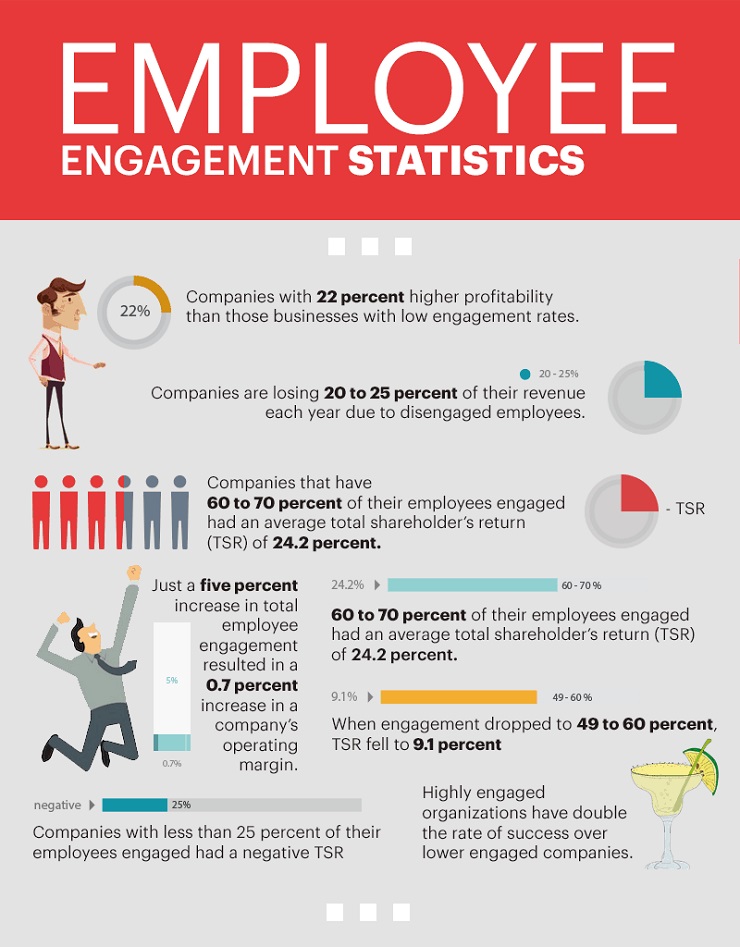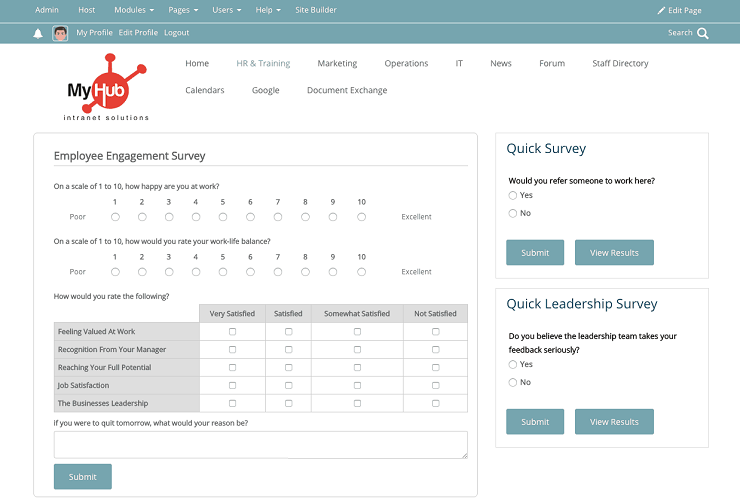You’re one week out from your first meeting with the new investors. For the last six months, your team has been working round the clock to create a minimum viable product. Finally, you have something truly world-class ready—all that’s left is to blow these investors off their feet with your pitch.
And then two of your core team members quit, because they’re no longer passionate.
When it comes to startups, one of the biggest hindrances to growth is losing key employees at the wrong times. Sometimes this is unavoidable. More often than not, though, keeping your team together is entirely in your hands.
The Key? Employee Engagement.
In short, employee engagement describes the persistent efforts you as a leader must take to make sure your staff stay excited, inspired, and happy in their jobs. If you think you can do it by just being a friendly person or playing cool music, sorry, it takes work. Fortunately, I’m about to give you a crash course in how to do it, and the payoff is big.
If you’ve been around the business world long enough, you’ve probably heard about the benefits of employee engagement. They’re all very real—true engagement can be a secret weapon for entrepreneurs, unlocking potential in your team that no dollar amount ever could.
We’ve all witnessed the difference between someone who loves their job, and someone who’s just there to pick up a paycheck. Put simply, the former is employee engagement in action. When your staff are engaged:
- They’re committed, always going the extra mile;
- They feel valued, and genuinely invested in the company’s success;
- You get the best out of your team;
- Absenteeism and lateness decrease;
- Retention and productivity increase;
- Health, safety, and performance all go up.
Trouble is, if you’re like most startups, your first dozen hires won’t include an HR manager. This means the responsibility of keeping your employees engaged and on board lies with you. It’s your job to make sure the flame doesn’t die out.
That’s not always easy.
Keeping staff inspired is a tricky area for many founders. Much like that old aunt who loves sharing family photos, you’re always going to have a higher level of passion than your team does. It would be unrealistic to assume otherwise—why would someone else make your dream their life mission? At best, you can hope for an 8 or 9 out of 10 on the enthusiasm scale, compared to your inherent 10 (or 25).
Hence the need for steady employee engagement efforts. Though your passion may never be quite replicated, staff who enjoy and are invested in their jobs will get stuff done, and stick around.
Here’s Why You Should Be Focusing On Employee Engagement

Ultimately, the real kicker is the impact on profit. Engaged organizations have been proven to be 22% more profitable than unengaged ones, while businesses where the majority of staff are engaged consistently return over 24% to shareholders. Clearly, engagement reaches further than just staff retention. These are powerful statistics—engaged workforces are profitable workforces!
This is not where the impact of engagement ends, however. If staff are unengaged, there’s a known ripple effect on co-workers. Negative attitudes spread like wildfire, and before you know it, one disengaged staff member has turned into a whole team of disengaged employees. Not only is this awful for staff morale and profitability, but is also a major safety risk. Research has shown that disengaged staff are 48% more likely to have an industrial accident, compared to their engaged counterparts.
Performance management and workplace grievances are another byproduct of a poorly engaged workforce. The hidden costs stemming from these can be significant, and it’s common for organizations with low levels of engagement to have high costs from grievance disputes, legal proceedings, and long-lasting sickness claims.
Not only that, research has shown that highly engaged employees have:
- 41% reduction in absenteeism;
- 17% increase in productivity;
- 10% increase in customer ratings;
- 20% increase in sales; and
- outperform other teams by an average 20% in sales and 10% in customer engagement.
To boil this all down, employee engagement increases profitability and retention. Higher engagement means more productive staff with fewer issues. They provide better service, meaning happier customers and a healthier business. These are probably benefits you’d like to see in your startup.
Information Overload: It’s Killing Your Team
Despite all of this being public knowledge, so many startups don’t do employee engagement well. In fact, for the last 15 years, only about 30% of employees in the United States have actually felt engaged at work, according to research from Gallup.
Why aren’t we doing something about this? Information overload!
Thousands of books and countless research articles have been written on the subject of engagement, and continue to be churned out every year. As a busy executive, it’s hard to know where to start. The result has been paralysis by analysis, with managers over-thinking engagement, and never implementing the right remedies. In this post, we’ve done the hard work for you and outlined four straightforward steps to boost employee engagement in your startup.
Engage Employees in 4 Steps, Without Spending Any Cash
Spoiler alert: it’s not all about puppies, beanbag chairs, and unlimited everything.
We’ve done the research for you, and below are four tangible steps you can take to increase engagement levels in your startup. These have intentionally been kept simple and easy to implement.
We understand that most startups are bootstrapping it, so pay raises and ideas heavy on cash have been left out as well. At the end of the day, improved engagement stems from creating the right human working environment first, which is what we focus on here.
1. Clarify Expectations and Purpose
Fundamental to any engagement is clear expectations. This means creating a clear sense of purpose, progress, and rules, as well as frequently giving feedback to your employees. Seem straightforward? It is, but without it your staff will be clutching at straws, attempting to do a good job without knowing what they’re aiming for, how they’re being measured, or even how they’re doing.
Uncertainty is a killer for engagement, so ensure that expectations are clarified upfront, and regularly reiterate them to ensure an engaged workforce.
Simon Sinek talks about the importance of sharing your organization’s purpose in his book Start With Why. “If you hire people just because they can do a job, they’ll work for your money. But if you hire people who believe what you believe, they’ll work for you with blood and sweat and tears.”
When communicating your organization’s purpose, you should include all your reasons for existence: Are you here to change the world, or just make money? Delight users, or just have a busy sales pipeline?
At the end of the day, your startup won’t die without a purpose. There are plenty of soulless corporates out there succeeding. But to truly shine, and to engage and retain your employees, a clearly communicated purpose is mission critical.
Put yourself in your team’s shoes. If they can’t see how their work adds to the overall mission of the organization, they’re going to check out soon. No one wants to feel like a cog in a machine picking up a paycheck—they want to be connected to something aspirational.
2. Celebrate!
People like praise. It’s crucial to be constantly celebrating, rewarding and recognizing the behaviors that line up with your organization’s values and mission. This can be as simple as a passing thank you or a staff lunch for a high performing team, or as complex as a formal employee recognition program.
No need to be dropping massive wads of cash here either; in fact, staff aren’t solely interested in financial rewards. The point here is that you need to be seen visibly acknowledging those who go the extra mile, to maintain their morale, and encourage other employees to do the same. Often it’s easy to get lost in the day-to-day of business, so it’s necessary to be intentional about creating time for celebrations.
One simple approach is to hold regular, fun events. Intentionally planning and taking the time to create an environment where staff can build connections with each other is a natural extension of celebration. The idea is to change your team’s perception and feelings towards work by association with the “warm fuzzies” that come from great events. Such events are easier to facilitate that you may think—look to your staff for ideas. No doubt they’ll be very forthcoming.
If your staff share similar interests, engage with them and indulge their interests. If not, it can be as simple as rotating through different interests (one night you might play Counterstrike, the next week you might have a square dancing class, for example). Mingling in this context also has the benefit of breaking down communication barriers between lower level employees and executives, allowing ideas, viewpoints, and ultimately better communication to flow.
Less formal, but equally as effective for engagement, is simple leadership. Take it back to the basics—thank your staff every day. Be infectious with your enthusiasm and gratitude. We’ve all experienced doing a fantastic job on something, and then having that effort go unnoticed. Make it your personal mission to never let this happen within your startup. You’d be surprised the difference a simple “great job on the presentation, I loved the graphics and really appreciate the time you put into covering those details” will make to your team’s engagement.
3. Sharpen Up Internal Communications
At the heart of an engaged organization is thriving internal communication. Good internal communication is more than just conveying information to your employees. It’s a two-way street. You need to be engaging in conversations, actively seeking the views of your staff, and showing them that their views are being valued, considered and acted upon. To do this well, it’s important to set up a system.
Try this:
- Team meetings where each person gets to share their biggest win and biggest concern or suggestion from the last week.
- Implementing a simple intranet to provide a communications platform for all staff, regardless of their geographic location.
- Having a physical or digital “suggestions box” where people can anonymously submit suggestions or improvements—then pick one each week or month to implement and share it with the team.
First impressions last. The biggest low-lying fruit when it comes to sharpening up internal communications is on-boarding, something that will be happening at every turn as your startup explodes (fingers crossed!). In fact, 28% of new hires are willing to quit their new jobs if they don’t find them satisfactory in the first 90 days.
Key areas to hit on immediately with your employee onboarding process are helping your new staff feel like they are part of your story. Paint the picture to them, talk them through the history, your struggles and wins; the future, your mission, values, and strategy; down to the nitty gritty of their personal contribution, goals and key responsibilities.
This kind of connection to the bigger picture drives deep engagement, particularly if you continue to check in with your staff at regular intervals to see how they’re doing and troubleshoot on any questions. Make sure you’re open to them by being accessible via the intranet or in person, and be transparent in your conversations. This builds trust, cuts out miscommunication, and promotes a feeling of unity within your company. Ultimately, this is engagement.
It’s easy to assume your new staff are happy and comfortable. After all, you are, and so are many of your long term staff. The key is to remember that every individual brings with them a wealth of different experiences and assumptions, and the first few months of employment are vital to cutting through these, and welcoming them into your organizational culture.
4. Look At The Data
In order to improve engagement, you need to know where you’re starting from. Benchmark engagement levels before rolling out any improvement initiatives, and set goals for where you’d like to get to.
Although they say the human heart is one performance variable that’s impossible to measure, we can get close. Straightforward ways to do this are through staff surveys, or focus groups for more in-depth analysis of potential engagement pain point in your business. With this starting point established, you can create a clear path for altering engagement levels over the coming years.
Source: MyHub
Surveys don’t need to be complex. The key is gathering data, and comparing changes week after week and month after month. Questions could be as simple as, “On a scale of 1-10, how satisfied are you with your work so far this week?” By measuring this every week, you can easily get an insight into whether or not your engagement efforts have been effective. Just ran a Counterstrike evening and saw a 20% bump in average ratings for this question? Looks like you now know what to do more of!
It’s also useful to draw on the Net Promoter Score methodology here, asking questions such as, “On a scale of 1-10, how likely are you to recommend working at to a friend or family at the moment?” This requires an employee to engage their reputation, rather than merely answering from a neutral point of view. SurveyMonkey or even just a simple Google Form can work well for this, or it can be incorporated as part of your intranet.
Simply set up a survey using the question above, send it out to your employees regularly (we’d recommend quarterly at least) and then track your average NPS score by taking the percentage of those with a rating of 9 or 10 (your promoters) and subtracting the percentage of those who rated you 0-6 (your detractors). Those who answered 7 or 8 are seen as passives. What’s most useful about this tool is that you’ll be able to track improvements over time. SurveyMonkey has a great guide to NPS over on their website.
Again, the most important aspect of engagement data is not so much what you’re measuring, or what the results are. Sure, this matters to an extent, but the real benefit comes from benchmarking, and seeing the effect of various initiatives on employee engagement.
Employee Engagement
Having a high level of employee engagement is the key to retaining the staff you need to scale your startup. But the benefits are rich and numerous. Though a seemingly abstract concept, the steps to getting there are quite straightforward: clarify expectations, celebrate your staff, sharpen up internal communications, and look at the data. Focus on these areas, and you’ll see the benefits in employee engagement levels, and your organization’s bottom line.
We’d love to hear your comments on any challenges you may have faced around employee engagement and any views on how you have been able to improve it—after all, we can all learn from each other!





















